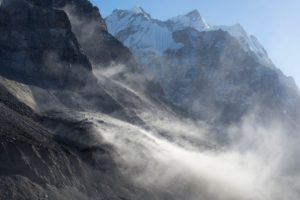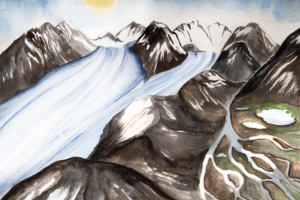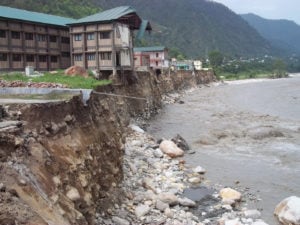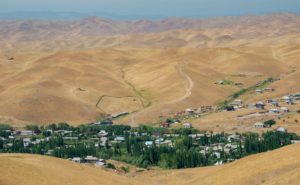Asia’s largest freshwater reserve is disappearing. In the Hindu Kush Himalayan region, which is warming by 0.3-0.7 degrees Celsius above the global average, global heating is melting the glaciers that blanket the planet’s highest peaks. Scientists now know that this catastrophic melt is being exacerbated by dust blowing from the Middle East. Moreover, they warn that as well as affecting Asia’s largest rivers, which are born from Himalayan glaciers and bring life and livelihoods to a quarter of humanity, the effects of glacial melt will extend well beyond the Himalayas, also impacting the Arabian Gulf region in turn.
Winds that sweep across Asia link the Hindu Kush Himalayas and the Gulf in an interconnected system. Globally, around 5 billion tonnes of desert dust from arid regions is swept into the atmosphere every year. Today, scientists can “understand the origins of this dust, where it lands, and how it interacts with local environments” thanks to satellite data and computer models, according to Chandan Sarangi, an earth system scientist at the Indian Institute of Technology Madras. Dust blows onto the High Mountain Asia (HMA) region from the Arabian Gulf, and as far away as North Africa and the southwest Arabian Peninsula, due to regional air currents and prevailing westerly winds.

These dust particles, Sarangi says, travel long distances at an altitude of 2-5 kilometres and reach the HMA during summer. Dust from arid regions such as the Thar desert in Pakistan and Saudi Arabia “gets lofted above the boundary layer [the lowest part of the planet’s atmosphere] of Earth by convection and gets transported to far places with wind at altitudes and deposited mainly above 3km”. The dust particles are thus deposited in the high Himalayan mountains, blanketing glaciers in a layer of particles that are darker than snow.
How dust in the Himalayas drives glacial melt
Particulate matter, black carbon and dust present a problem for Himalayan glaciers because of their low albedo.
Albedo means how well a surface reflects the energy of the sun. White surfaces reflect solar energy and have a high albedo, whereas black surfaces absorb energy and have a low albedo. The albedo effect of the Earth’s ice caps has a significant impact on global temperatures.
Clean glacial snow has a high albedo, which means that it absorbs very little sunlight and reflects most of the incoming rays back into space. Darker dust and soot, however, absorb much more of the incoming solar radiation, which warms and therefore melts the glaciers below. In many areas, aerosols like dust and soot significantly exacerbate the impact that atmospheric greenhouse gases have on glacial melt, producing quicker and more direct warming effects.
Black carbon from vehicle exhausts, waste burning and the combustion of biofuels in South Asia’s big cities was previously thought to be the primary aerosol driving glacial melting in the Himalayas.
However, a more recent study published in November 2020 by a team of international researchers including Sarangi found that at altitudes above 4,000 metres, dust is a greater driver of melting than black carbon. Sarangi notes that “the majority of black carbon reaching HMA is emitted by anthropogenic activities in the Indus and Gangetic plains, which gets deposited at 0-3 km elevations. Hence, black carbon deposition is higher than dust below 3 km elevation and vice versa.”
While dust blowing from the Middle East to the high Himalayas is not a new phenomenon, it has only recently been understood to be one of the primary causes of glacial melting. Further research is needed to better understand if the amount of dust being blown across the continent has increased over the years, or if the same amount of dust is now having a larger impact on glaciers due to higher temperatures. Such research would not only help to better determine the role of dust in accelerating melting of glaciers in the Himalayas, but could also help in the design of interventions needed to minimise its impacts.
Dust has always been carried around the Earth by its natural systems. But researchers have found that since the start of the Industrial Revolution in 1750 the amount of dust in the Earth’s atmosphere has doubled.
Sea changes
The winds that carry dust across the continent to the Himalayas also bring the consequences of glacial melting back to the Gulf region. Warming mountains mean warmer winds, which have begun to fundamentally shift monsoon patterns across Asia and the Middle East.
Monsoons are integral to the ecosystems of the Arabian Gulf. John Burt, a marine biologist and professor at New York University Abu Dhabi explains that “widespread coral bleaching in the Gulf is the result of low shamal winds [strong north-westerly winds that blow across the Middle East] during summer. Those shamal winds are generated by a pressure gradient driven by the monsoon. If the monsoon weakens, so will shamals, leading to more frequent and/or severe coral bleaching in the Gulf region.” Coral reefs in the Gulf are increasingly vulnerable, and every effort should be made to protect this ecosystem from further damage.
A study published in Nature last year linked shrinking glaciers to the decline in fisheries in the Arabian Sea, caused by the same shifting winds. Altered monsoons have created the perfect conditions for a single-celled algal organism called Noctiluca scintillans to multiply by the millions. Harmful algal blooms suck oxygen from the water, creating oxygen deficiencies and suffocating fish populations. Algal blooms exacerbate coral bleaching and replace the indigenous algae that are a source of food for fish. Scientists warn that the spread of Noctiluca driven by changes in the Himalaya poses a significant threat to local fisheries in the Gulf, creating wide-reaching implications for food security.
Burt warns that the same algal blooms that are choking fisheries also threaten the UAE’s fresh water supply. “Noctiluca is a major issue for desalination plants, where blooms will clog reverse osmosis filters and shut down operations. This happened with another algal bloom in early 2009, when a red tide resulted in closure of desalination facilities on the UAE’s east coast. The result was loss of potable water for much of the northern Emirates.”
Through intercontinental winds blowing in both directions, the crisis facing the Himalayas’ glaciers is intimately linked to the Arabian Gulf in both its causes and effects. It is clear that the fate of the two regions is intertwined and that we cannot continue to view climate change in the Himalayas as a solely regional threat. In addition to the direct ecosystem-level link between the Himalayas and the Gulf, socio-economic impacts, particularly through increased stress in South Asia, are just as pressing.
While it may be difficult to limit the dust that ends up in the Himalayas and address the associated ecosystem impacts in the Arabian Gulf, more research is needed to fully explore the links between the regions, and what can be done to mitigate climate impacts at both ends of the system. What is clear is that there needs to be more dialogue with the Gulf countries to support timely interventions, including in research, to come up with solutions before it’s too late.




